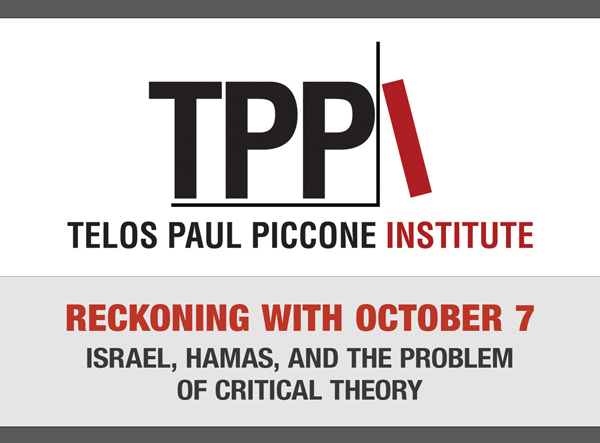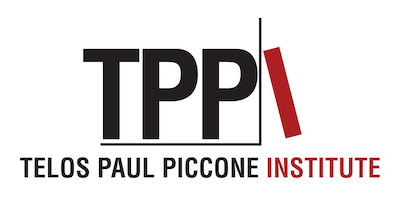For Gabriel Noah Brahm’s preface to this essay, click here.
 In the first panel of TPPI’s Israel Initiative webinar series devoted to discussing the atrocities of October 7, one of the chief points of debate was whether critical theory—or any other theory—was up to the task of reckoning with Hamas’s massacre of Jews and its ensuing embrace from certain parts of academia.
In the first panel of TPPI’s Israel Initiative webinar series devoted to discussing the atrocities of October 7, one of the chief points of debate was whether critical theory—or any other theory—was up to the task of reckoning with Hamas’s massacre of Jews and its ensuing embrace from certain parts of academia.
Abe Silberstein cautioned that it is not helpful to emphasize the disruptive character of these attacks or the notion that something new has happened. Instead, violence like this is, unfortunately, what human beings have been doing to each other for a long time. And Silberstein, thus, seems committed to the tough work of theorizing about these events and distinguishing carefully where their academic boosters have erred in their theorizing about them.
Cary Nelson, Gabriel Noah Brahm, and Manuela Consonni, however, held that there is not much theory going on. Nelson even admitted that “no theory that I’ve been working with for the past sixty years” is up to the job of understanding or explaining this event. Consonni also cautioned that it’s not a matter of “whether or not Franz Fanon is being followed.” They agree that there is something more sinister at work than bad theory.
The question both sides attempt to answer is, can a theory explain a massacre, and further, should one try? Is there a logic to these events, or not?
I was struck by Nelson’s coming to a loss after thinking through so many theories. Now, Reinhold Niebuhr once famously claimed that original sin is “the only empirically verifiable doctrine of the Christian faith.” As a Christian, I confess to seeing the events of October 7 as plain empirical verification. That is not the end of how I think about these events, or the war in their aftermath. But it is the beginning.
Here, I do not mean to convert Nelson, Silberstein, Consonni, or Brahm to a simplistic notion of total depravity or original sin. But I do think the inherently fallen nature of the human being, individual and collective, works pretty well to satisfy the good points brought up by all four. Indeed, such horrible violence as rape, murder, ethnic cleansing, and so forth has long been a part of what humans do to each other, as Silberstein notes. Yet the horror of such events does apparently exceed the theorist’s rational and moral ability to grasp it.
In this light, I think the terms “sublime” and “saturated phenomenon,” borrowed from continental phenomenology, are apt. The event cannot be explained by theoretical means, and if it could, then it would have been explained away. Such a horror, universal as it is to human history, still calls for a metaphysical, even spiritual understanding, one that simply proclaims, as Joseph de Maistre put it, that the human will is “fatally wounded,” for man “does not know what he wants; he wants what he does not want; he does not want what he wants; he would want to want. He sees in himself something that is not himself and that is stronger than himself.” Put in the present context: all have the capacity for radical evil, even in pursuit of what they think, but do not know, they want; but radical evil, being an absolute rebellion, a drive toward nothing, cannot be explained by theory, let alone justified. So the doctrine of original sin explains, but only by positing that evil inheres in each person and describing that inherence as a mysterious affront to reality. Again, I don’t expect non-Christians to buy that. But I do think the doctrine is very good at providing an alternative (to) “theory,” akin to what Silberstein is after, while remaining apophatic enough to avert from the reductionism toward which other, more ambitious theories tend.
Where original sin is truly interesting for this conversation, however, is not in its explanation of the events of October 7. Rather, it becomes downright compelling if we use the doctrine to understand how so many students, professors, administrators, and others in the (supposedly) most rational halls of academia could have cheered these actions on one day later. For the teaching on original sin tells us that this radical evil lies not only in the worst corners of human souls but also in the best and most rational of intentions.
In his last novel, The Thanatos Syndrome, Walker Percy prophesied that the intellectuals—and intellectualism—would come to embrace antisemitism, as had already happened in Germany years before. In an early scene, Dr. Tom More, the main character, a psychiatrist and on-and-off believer in both the Catholic faith and the victories of science, meets his former priest, Father Smith, in a fire watchtower. The latter is, apparently, out of his mind, though as More talks with him, he realizes Smith’s ramblings are attempts to explain the existence of God, the Jews, and radical evil in the modern world, that world in which a local doctor is planning to close the hospice care facility and set up a euthanasia clinic. Smith’s arguments are relevant:
“They have their reasons. Not bad reasons, are they? They make considerable sense, wouldn’t you agree? They’re not bad fellows.”
“[Most] word signs have been evacuated, deprived of meaning something real. Real persons. Not so with Jews.”
“The Jews as a word sign cannot be assimilated under a class, a category, or theory. No subsuming Jews! [. . .] This offends people, even the most talented people, people of the loftiest sentiments, the highest scientific achievements, and the purest humanitarian ideals.”
“You are an able psychiatrist, on the whole a decent, generous, humanitarian person in the abstract sense of the word. You know what is going to happen to you? [. . .] You are a member of the first generation of doctors in the history of medicine to turn their backs on the oath of Hippocrates and kill millions of old useless people, unborn children, born malformed children, for the good of mankind[. . . .] Do you know what is going to happen to you? [. . .] [Y]ou’re going to end up killing Jews.” [Emphasis added.]
As odd as they might strike the reader, these reflections have much to teach us, now more so than ever. Why does a modernist, feel-good, progressive rationalism, one that wishes good to all and everyone in general, end up killing Jews? Perhaps it is because the very notion of the Jewish people strikes the progressive as something irrational, or something claiming to be above reason, meaning above the universal—as Smith claims, the particular that cannot be subsumed into the general. The Jewish people owe their existence to a God picking someone, after all.
As discussed in the webinar, the specter of Frantz Fanon looms over the events of October 7 and their academic justifications. It is important that we recognize the role of the therapeutic in his treatment of decolonialist violence. Whether prescriptive or not (as Silberstein’s reading claims it’s not), it is nonetheless striking that Fanon treats such violence—not the cold, systematic slaughter of the Holocaust but even the terrible chaos more akin to gliders and machine guns and riots—as a sort of medical remedy to a repressed psychosis. Even the irrational gets rationalized into technique.
It is little wonder that many in the academy have embraced such a notion, whether superficially or accurately. As the restrictions during the Covid pandemic have clearly shown, the academy is most comfortable in tender talk of therapeutics and medical solutions, even and especially when it is enforcing rules that, at best, only make sense on paper. I am not surprised that similar language and action devolved into its absurdity on October 8. On a personal note, I’ve found a general pattern among the most strident defenders of Hamas: they are degree holders in social work.
If there is any role for theory in this, then, it is in analyzing and criticizing these notions of social pathology, medicine, therapy, and therapeutic violence. Simply put, these notions baptize evil in the language of self-care and care for others’ self-care. And they are very popular among the younger generations today. I fear the embrace of terrorism we are seeing in these corners of the academy is all too medical.
But Percy’s insight into rationalism and antisemitism might also warn the theorist himself. After all, what is the ideology of social therapy—even the worst ideologies found in parts of pseudo-scientific psychology—but an attempt to put into practice what the critical theorist had originally claimed? That theory is a technical and practical enterprise to understand and thereby manipulate the world, the world having become so penetrated by human reason that it is now rationally manipulable—all for the sake of greater universal liberation. As Marx said, until now the philosophers have only tried to interpret the world, but now we must change it. The social workers, confident that we have come to systematize and mechanize human society, are set out to do all the changing through their therapies. If only we can get the right theory, then we can fix them. Odd that the fixing, as Smith warns, always seems to end in killing Jews.
In sum, I worry that critical theory itself, conceived in its modernist and hyper-modernist form prevailing today, is not up to the task of understanding what is happening with contemporary antisemitism. It may even have some critique in store for itself. At the very least, it might question some of its own premises, and let a doctrine of original sin help it do so. Is there anyone innocent? Is socialization where most ills reside? Are forms of socialization perfectible? Can they even be changed through critical theoretical means? Or do critical theory and bureaucracy—the latter having shown itself, if only in bumbling embarrassment, an uneasy ally to supporters of Hamas in the academy—have an unsettling kinship, one that we are witnessing in American higher education?
As for me, I remain impressed that Walker Percy seems to have been right. The intellectuals’ attempts to change the world—in the optimism that the world can easily be changed for the better, that if only we thought right, we would start acting right, because we are all good deep down and just need to be liberated—keep ending in killing Jews. Or at least in the American academy, cheering on the killing of Jews.
Casey Spinks writes from Waco, TX, where he is a Ph.D. candidate in theology at Baylor University and teaches in the philosophy and religion departments.









